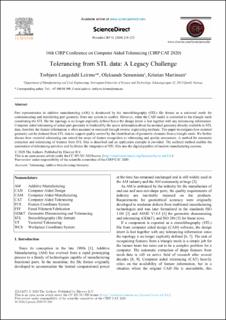| dc.contributor.author | Leirmo, Torbjørn Langedahl | |
| dc.contributor.author | Semeniuta, Oleksandr | |
| dc.contributor.author | Martinsen, Kristian | |
| dc.date.accessioned | 2020-09-29T08:37:29Z | |
| dc.date.available | 2020-09-29T08:37:29Z | |
| dc.date.created | 2020-08-17T14:27:48Z | |
| dc.date.issued | 2020 | |
| dc.identifier.citation | Procedia CIRP. 2020, 92 218-223. | en_US |
| dc.identifier.issn | 2212-8271 | |
| dc.identifier.uri | https://hdl.handle.net/11250/2680167 | |
| dc.description.abstract | Part representation in additive manufacturing (AM) is dominated by the stereolithography (STL) file format as a universal mode for communicating and transferring part geometry from one system to another. However, when the CAD model is converted to the triangle mesh constituting the STL file the topology is no longer explicitly defined hence the design intent is lost together with any tolerancing information. Computer aided tolerancing of actual part geometry is hindered by the sparse information about the nominal geometry directly available in STL data, therefore the feature information is often assumed or recreated through reverse engineering methods. This paper investigates how nominal geometry can be deduced from STL data to support quality control by the identification of geometric elements from a triangle mesh. We further discuss how vectorial tolerancing can extend the scope of feature recognition to tolerancing and quality assessment. A method for automatic extraction and tolerancing of features from STL files is described and an application example is provided. The outlined method enables the automation of tolerancing activities and facilitates the integration of STL files into the digital pipeline of modern manufacturing systems. | en_US |
| dc.language.iso | eng | en_US |
| dc.publisher | Elsevier | en_US |
| dc.relation.uri | https://www.sciencedirect.com/science/article/pii/S221282712030946X | |
| dc.rights | Attribution-NonCommercial-NoDerivatives 4.0 Internasjonal | * |
| dc.rights.uri | http://creativecommons.org/licenses/by-nc-nd/4.0/deed.no | * |
| dc.subject | Geometrisk analyse | en_US |
| dc.subject | Geometric analysis | en_US |
| dc.subject | Additiv tilvirkning | en_US |
| dc.subject | Additive manufacturing | en_US |
| dc.subject | Geometriske toleranser | en_US |
| dc.subject | Geometric Tolerances | en_US |
| dc.title | Tolerancing from STL data: A Legacy Challenge | en_US |
| dc.type | Journal article | en_US |
| dc.type | Peer reviewed | en_US |
| dc.description.version | publishedVersion | en_US |
| dc.subject.nsi | VDP::Industri- og produktdesign: 640 | en_US |
| dc.subject.nsi | VDP::Industrial and product design: 640 | en_US |
| dc.source.pagenumber | 218-223 | en_US |
| dc.source.volume | 92 | en_US |
| dc.source.journal | Procedia CIRP | en_US |
| dc.identifier.doi | 10.1016/j.procir.2020.05.180 | |
| dc.identifier.cristin | 1823657 | |
| dc.description.localcode | © 2020 The Authors. Published by Elsevier B.V. This is an open access article under the CC BY-NC-ND license (http://creativecommons.org/licenses/by-nc-nd/4.0/) | en_US |
| cristin.ispublished | true | |
| cristin.fulltext | original | |
| cristin.qualitycode | 1 | |

